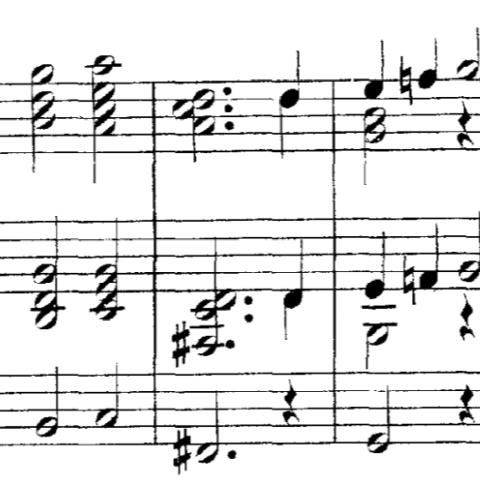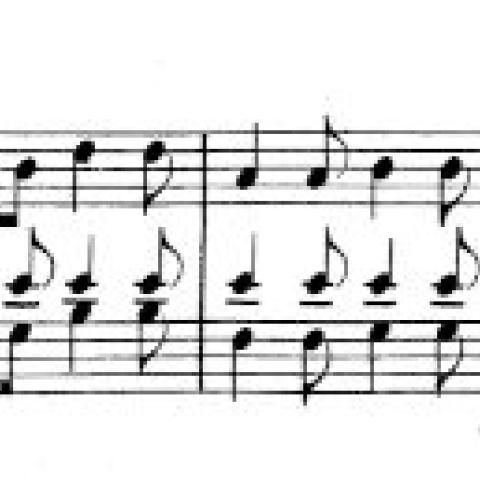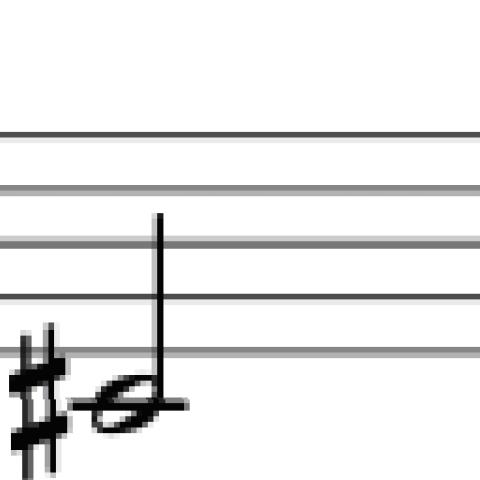
Further thoughts on
counterpoint II: a miscellany
I mentioned at the end of last month’s column that I have been rethinking some of my ideas and practices about teaching rhythm and counting. This is the result of recent experiences teaching students contrapuntal voices. I have noticed—more than I previously observed—that moving from an understanding of the rhythm of individual voices to an understanding of the way the rhythms of those voices fits together is not always easy or natural for everyone. It is helpful to address it directly, and I developed some new ideas about how to do so.
As outlined in my April 2012 column, my approach to teaching rhythm and counting involves ignoring time signatures, bar lines, and the “one-and-two-and” structure that we often employ. Rhythm is about ratios, and my experience has suggested that grappling with ratios directly—understanding that a dotted quarter note lasts as long as three eighth notes, that a half note lasts twice as long as a quarter note, and so on—is the best way for a student to become comfortable with rhythm. This is true for a beginner learning to understand rhythmic notation for the first time and also for a more experienced student who is having trouble with a particular rhythm or needs a refresher course. This has the advantage of being simple and completely accurate. I have seen much more trouble arise when students worry about whether a particular note is “on the ‘and’ of two” than I have seen clarity arising out of this way of describing rhythm.
This is an over-simplified summary of an approach that differs from other approaches in emphasis, since the learning of note ratios is always fundamental. This is not the place for a complete restatement of what I wrote six years ago, or to explain why I believe that it is a good approach. You can find it in the above-mentioned issue of The Diapason, which I have posted at http://gavinblack-baroque.com/Diapason column April 2012.pdf.
When a student needs to work out the rhythm of a passage, I suggest counting individual notes in relation to a suitable short note value. For example, if that short unit is the eighth note, then each eighth note is counted as “one,” each quarter note is counted “one-two,” each half note “one-two-three-four,” and so on. This does not involve denying that those beats also relate to positions in a measure, but it just deemphasizes that at first. In learning the rhythm of a single line or passage, the texture of which involves all of the notes, voices, chords, etc., being in the same rhythm as one another (say in the manner of many hymns), this approach is very successful.
Therefore, it is also successful when learning individual voices of what will be a contrapuntal texture, regardless of its eventual level of complexity. So the following two “voices” (the pitches are not important) could each be counted as indicated in Examples 1 and 2. As with any rhythmic counting, the numbers have to come at an even pace.
Each of these examples contains nineteen eighth notes, and the two of them fit together. But the sort of counting that I have suggested would be extraordinarily hard, if not impossible, to follow in Example 3.
The first-order solution is that the rhythm of each voice should be internalized before the voices are put together. This is a goal worth striving for in the practicing process. However it seems sensible to readmit traditional measure-based counting at this point.
I have purposely created an example that is not divided into measures. But it could be, like Example 4, which then allows for the regular (“one-and-two-and”) approach to counting.
I believe that it is a good idea for this sort of counting to be secondary. To the extent that working out the rhythm of each voice separately is something that must be approached consciously and deliberately, I think that my per-note way of counting is useful. In addition to being sensible and effective in itself, it can promote an awareness of the importance of the middle and ends of notes, whereas “one-and-two-and” counting, especially with counterpoint, can focus attention disproportionately on the beginnings of notes. As soon as the measure-based number for a note has been spoken or thought, the next step is to see what notes in other voices correspond to the next counting numbers. This can shift a player’s overall focus toward a more homophonic feeling.
Thinking about applying the normal measure-based templates to counting multi-voiced pieces has made me more open to other ways of keeping track of the rhythm of pieces that are not derived from a strict awareness of the voice structure. For example, there is net or overall rhythm. Sometimes, while the rhythm of each voice in a contrapuntal passage is different from all the others, the surface rhythm is quite simple. That rhythm might be thought of as a new note every eighth note.
Here are a few examples of writing in which this concept might make things easier. Example 5 is from Bach, Art of the Fugue, Contrapunctus 8. Example 6 is from Mendelssohn, Prelude and Fugue, op. 37, no. 1 (fugue). Example 7 is taken from Bach, Well-Tempered Clavier, Book II, Fugue #2.
In the last of these, the net rhythm is more complicated, but still simpler than each individual rhythm. It is interesting that the first three measures of each piece have the same overall surface rhythm, which in turn is the rhythm of the fugue subject. In the opening measure, the fugue subject is alone, in the second it is combined with a countersubject that does not change the surface rhythm, and in the third measure only the surface rhythm alludes to or quotes that subject.
If the printing is neatly aligned, it is possible to derive all of the rhythm from the surface rhythm by how things line up. Sometimes it is useful to picture a cursor line going steadily from left to right and to identify whatever it touches as what is to be played at that moment. But this should all be secondary, understood to be forms of assistance, not a primary way of understanding rhythm.
Some observations
Here are a few more observations about counterpoint, some of which may be a bit abstract:
It is natural to think of counterpoint as being something that is easily differentiable from harmony. After all, there is counterpoint that exists outside the norms and expectations of tonality or functional harmony. But for most of the music that we play on the organ and other keyboard instruments, pieces that are rigorously contrapuntal are also completely embedded in harmony. This is something essential about the meaning of the counterpoint itself: that is, the way that the flow of contrapuntal voices/melodies comes across to us, and therefore the way that the directionality of the different voices interact with one another function, is determined crucially by where the voices are moving harmonically.
For this discussion, I have invented an exercise. Try playing a piece of contrapuntal music with all but one of the voices transposed, and not each transposed by the same amount. The simplest case would be something like Example 8, from the opening of the first Bach Two-Part Invention.
This is going to sound discordant, to put it mildly. But that reaction or judgment is not necessary. The point is that it sounds radically different from the “real” version, although, analytically, a good deal of the counterpoint itself remains unchanged. A little bit of this exercise, possibly even just the amount that I have written out here can be eye-opening for a student. (It is not bad as an odd sort of sight-reading exercise either, and it is much harder with more than two voices.)
A bit of exposure to this oddity can also make the ears more sensitive to the ebb and flow of harmony-based motion or pressure in contrapuntal works. Even though the interaction of voices is always shaped in some way by the separate voices’ harmonic direction, the evident force of that phenomenon is stronger in some places, yet weaker in others. It is also more divergent in some places and more in sync in others. The places where the force of the harmonic direction of different voices is most in sync are cadences and moments that feel cadential.
Many years ago, probably when I was still in high school, an older friend of mine recounted something that a friend of hers had said. This friend once removed was an extremely erudite and thoughtful music listener, thinker about music, and keyboard player. The comment that was relayed to me was: “Helmut Walcha’s problem is that he is too focused on the counterpoint.” I immediately felt that I was learning something—not so much about music or playing or performance, but about attitudes toward musical work. The first thought that occurred to me was that Helmut Walcha was not the one with the “problem!” The phrase “Helmut Walcha’s problem is . . .” really meant, “The reason that I do not like Walcha’s playing is . . . .” That comment and my reaction to it at the time taught me that many people take their own reactions for objective truth, and that it made me uncomfortable. That in turn has shaped a great deal of my own approach to my development as a player and teacher.
What does that comment tell us about counterpoint? I have never thought that it was an apt description of anything I heard in Walcha’s playing. That may be in part because I grew up listening to him, and, at that time, his approach was my own default. But it has made me sensitive to the question of what it would mean to pay too much attention to counterpoint and too little to other things.
My guess is that this commentator was probably referring to Walcha’s relatively steady approach to rhythm, and also, just as importantly, to his focus on consistently phrasing subjects. (For what it is worth, he was also reacting to hearing recordings, not to any conversations with Walcha or to any direct knowledge of the roots of his approach.)
This leads to a host of questions:
Is it correct that relatively steady metronomic playing is associated with bringing out counterpoint clearly, whereas playing that is rhythmically free is associated with harmonically derived music, or with an approach to playing music that is more focused on harmony?
What about the business of “subject phrasing?” If a phrase, theme, or motif happens more than once in a piece, is it important to articulate and phrase it consistently? Does doing that enhance the extent to which the counterpoint seems like counterpoint?
Is it important, or is it good or bad, for the notes of different voices that are written ostensibly at the same time to happen at exactly the same time? Could there be something good or necessary about notes being somewhat staggered at times? The reason that I associate this question with the Walcha-related anecdote is that in his playing, notes do line up rhythmically to a great extent. Furthermore, the above-mentioned commenter believed that Walcha was too focused on counterpoint. But there are many players and theorists who believe that counterpoint is enhanced by staggering: it is difficult for the ears to follow separate lines if the notes of those lines coincide with one another exactly. Which of these is true? Does it depend in part on habits of listening? Is it really about clarity of counterpoint, or is it about some other aspect of style?
How does this relate to thoughts about basic counting in counterpoint expressed above? I suppose that I feel most interested in the notion that any melody including a contrapuntal voice has some logic by which it might be stretched out or otherwise inflected rhythmically. Also, two voices that occur at the same time might have different logic. They might not line up all the time, but not because the phenomenon of their not lining up should be sought out, rather, because the internal logic of each has them manifesting slightly different timing. This may be why I am more interested in counting individual voices that are somewhat removed from each other and from the template of measures. But then all voices have to be together enough in the end so that the piece is coherent.
I present all of this as questions or ideas that are interesting to think about or, more to the point, to engage with in conjunction with students. None of it is hard and fast; none of it represents answers or conclusions.
One last topic: notes that we play have overtones. On the organ some of those are the inherent overtones of the pipes, while some are the higher stops added for a particular purpose. Especially in the former category, there are often overtones that, while they blend in enough to make the sound coherent, can also be heard as faint separate notes. And the rather cool thing is this: different overtones are relatively audible on different notes. So in playing a theme you might hear the twelfth over the first note, the fifteenth over the second note, the twelfth again, then the seventeenth, and so on. In Example 9, in this melody, you might happen to hear the higher (gray) notes as very faint, audible accompaniment to the “official” theme.
This is a kind of shadow overtone counterpoint that is always present, at a greater or lesser degree of audibility, and is present separately in multiple contrapuntal voices when they combine.
Gavin Black is director of the Princeton Early Keyboard Center, Princeton, New Jersey. He can be reached by email at gavinblackbaroque@gmail.com.





